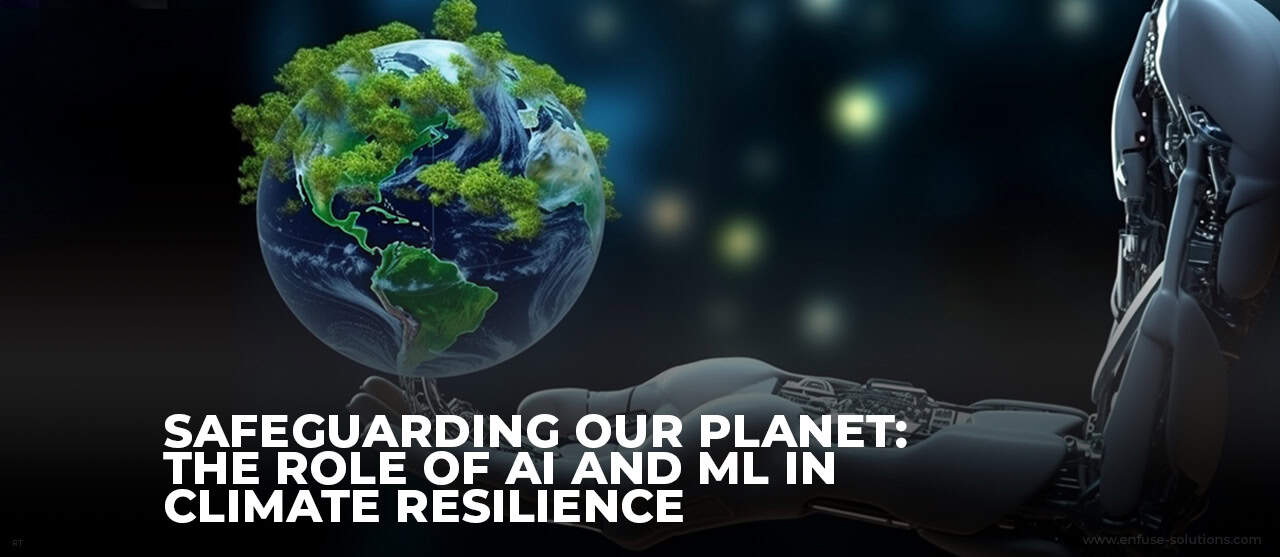
In 2023, we glimpsed the potential consequences looming over future generations: scorching heat waves, rampant wildfires, deluging downpours, and inundating floods. Notably, it marked the hottest year on record, urging us to wield every tool available to combat and adapt to these challenges. Enter AI and ML, potent allies in the fight against climate change, bolstering environmental resilience.
Join us as we delve into their pivotal role in protecting our planet and forging a greener tomorrow.
Understanding Climate Resilience
Ecosystems, communities, and economies must possess the capacity to endure and rebound from climate variations and transformations: this is what we define as “climate resilience.” Yet numerous impediments thwart such durability, among them is the escalating frequency of extreme weather events that not only threaten immediate infrastructure hazards but also compromise food security along with human well-being.
Limited resources and infrastructure render marginalized communities particularly vulnerable to climate change impacts, thus intensifying existing social disparities. This escalating vulnerability escalates risk levels and constrains adaptive capacity. Moreover, the complex association between climate change and health outcomes magnifies hazards, culminating in escalated mortality rates as well as economic burdens.
WHO reveals a daunting statistic: an estimated 3.6 billion people currently inhabit areas highly vulnerable to climate change; furthermore, they project that between 2030 and 2050, a mere two decades, this phenomenon will precipitate an alarming spike in annual deaths. Malnutrition, malaria, diarrhea, and heat stress are expected alone to contribute to approximately 250,000 additional fatalities each year.
Furthermore, three crucial facts emphasize the critical necessity for pioneering solutions to bolster climate resilience: the amount of carbon dioxide in our atmosphere is more now than it has ever been, human activity has contributed to two-thirds of extreme weather incidents in the past two decades, and sea levels are increasing quicker now than ever before. Tackling these challenges mandates a multifaceted approach and just strategies, coupled with utilizing advanced technologies such as AI and ML for proactive measures toward a sustainable tomorrow.
AI And ML: Catalysts For Climate Resilience
1. Data Collection And Analysis
AI and ML application in gathering and examining data greatly helps with adapting to climate change. NASA’s distant sensing tool called the Moderate Resolution Imaging Spectroradiometer or MODIS for short, takes important information about the environment from satellite photos of Earth’s land, ocean, and atmosphere. These techniques provide valuable insights into processes such as deforestation or glacier retreat and aid in the study of the effects of urban sprawl on climate change.
AI modeling expedites the analysis of Earth’s climate system through intricate algorithms, enabling the prognostication of prospective climate scenarios and impacting adaptation strategies. Another example is the Community Earth System Model (CESM), which utilizes ML to improve its simulation of cloud dynamics, enhancing the precision of its climate projections.
2. Predictive Analytics And Forecasting
Predictive analytics and forecasting utilize AI and ML techniques in a pivotal role to mitigate climate-related risks; these tools allow us not only to anticipate severe weather events but also their potential impacts. Furthermore, by pinpointing regions most susceptible to climate change, this advanced methodology becomes increasingly effective.
The European Flood Awareness System (EFAS), an innovative alert system that harnesses the power of AI algorithms for meteorological data analysis, offers timely flood warnings up to 10 days prior. Anticipating and mitigating the consequences of such events, we can employ this knowledge to save lives and reduce damage. Governments and organizations can also utilize predictive analytics in resource allocation as well as evacuation planning; furthermore, it supports climate resilience strategy development for vulnerable populations.
3. Optimization And Resource Management
AI algorithms in smart grids predict energy demand, control peak loads, and maximize the distribution of energy by incorporating sustainable sources. For example, Google’s DeepMind implemented advanced ML algorithms. This optimization led to a substantial 40% decrease in power consumption within their data centers.
Moreover, with its capacity to manage resources effectively, AI can play an instrumental role in regions prone to droughts and other climate-related calamities when it comes to managing necessities such as water or food. By meticulously examining data on resource usage and availability, cutting-edge technologies can assist governments and organizations in efficiently distributing resources. This capability ensures that vulnerable communities have access to essential commodities.
4. Disaster Response And Recovery
AI critically optimizes resource allocation and enhances situational awareness during disaster response and recovery operations. Systems such as the UN’s Humanitarian Data Exchange (HDX), powered by AI, gather data from diverse sources for analysis to guide relief efforts; this aids in efficiently distributing humanitarian assistance.
Post-disaster assessments become vital tasks conducted with advanced-capability AI-powered robotics, including drones featuring object detection along with autonomous navigation functionalities. After Hurricane Maria devastated Puerto Rico in 2017, AI-powered cameras on drone technology efficiently surveyed the damaged infrastructure and remote areas. This swift coordination of relief operations was made possible by this advanced approach; it ensured both speed and safety in executing necessary measures post-disaster.
5. Advanced Climate Change Research
AI and ML advancements are propelling climate change research by unlocking insights from vast datasets and improving climate modeling accuracy. ML techniques, including deep learning and neural networks, analyze satellite imagery, climate records, and environmental sensor data to identify complex climate patterns and trends. For instance, AI models can now predict short-term global climate phenomena such as El Niño and La Niña events, almost 18 months in advance, aiding in climate forecasting efforts.
Furthermore, climate models that are turbocharged with AI technology, just like the ones made up by the European Centre for Medium-Range Weather Forecasts (ECMWF), crank out predictions of future climate scenarios that are mighty accurate. That way, decision-makers can gauge how well their efforts in cutting emissions and adjusting to changing conditions measure up against potential threats posed by our fickle weather patterns.
Conclusion
The pressing quest for climate resilience demands the incorporation of AI and ML as a catalyzing force, presenting groundbreaking strategies that surpass customary adaptation methods. Beyond mere mitigation of climatic consequences, AI and ML bestow us with the ability to foresee and contend with environmental obstacles proactively.
By revolutionizing data acquisition and examination, predictive analysis, resource administration, disaster response, and climatological research, these technologies furnish indispensable instruments for fortifying robustness. By collaborating across disciplines and strategically deploying AI solutions, we can adjust to the evolving climate and also promote sustainable growth and fair results. This will pave the path towards a stronger and prosperous future for generations to come.
EnFuse Solutions stands at the forefront as a premier provider of AI and ML Enablement services worldwide. Our mission is to empower businesses by enhancing their AI and ML capabilities, thereby elevating their operational outcomes. We offer comprehensive tagging, labeling, and annotation services tailored to individual projects or as part of a continuous managed service, ensuring sustained success for our clients.

















Comment